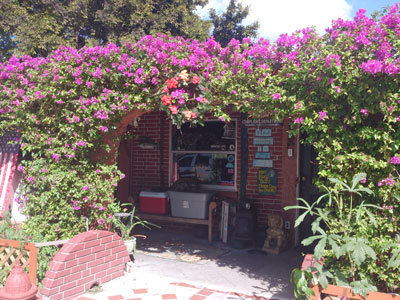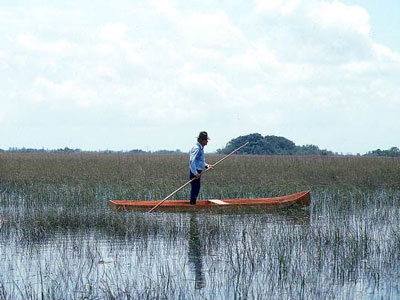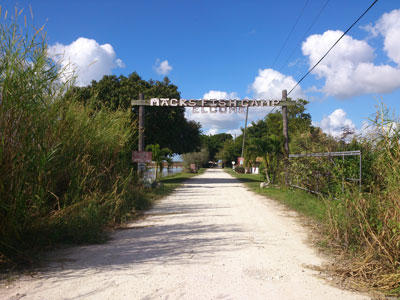
Gladesmen took care for land — then, now
SHARK VALLEY, Fla. — Once upon a time, when concrete roads and highways were still futuristic dreams of urban developers, when alcohol was forbidden and the Great Depression looming, there was a South Floridian wilderness that was still untamed and free.
It offered an ecosystem that was rich with deer, raccoons, opossums, rabbits, turtles, salt and freshwater fish, wood storks, coots, wild ducks and turkeys. There was a natural landscape that was filled with vast mangrove forests and miles and miles of wetlands and swamp interspersed with sloughs and so-called gator holes.
| The main house at Mack’s Fish Camp was used as German fort in the Humphrey Bogart movie “The African Queen” (Photo by Patrick Riley). |  |
The locals called it the “great river of grass.” We know it today as the Everglades.
There, in the midst of this harsh, yet opportunistic, environment there was a group of men who were as deeply rooted in the nature that surrounded them as the trees that afforded them shade. These men sought to live in unison with their habitat and to take from it just what they needed. At the turn of the century and up into the 1940s they were often referred to as “swamp rats,” “glade hunters,” and “crackers.”
We know them today as gladesmen.
“The gladesman is a cultural heritage that is being carried in present day society by people who either live in the Everglades or recreate on a regular basis and actually are good stewards of the land,” said Marshall Jones, a fifth-generation gladesman who operates an airboat rental business (Mack’s Fish Camp) with his twin brother Keith.
“That is the bottom line. If you aren’t a steward of the land, you can’t consider yourself a gladesman, because this is an environment that is very hardy, but at the same time very fragile,” he added
While Jones concedes that technology has changed some of the ways present-day gladesmen operate, most of their daily routines are still deeply connected to lives led by the original gladesmen.
One of them was Glen Simmons.
Born in 1916, Simmons “grew up on Long Glade, a small settlement located between the fledgling towns of Homestead and Florida City, which now border perimeter of Everglades National Park” writes Dr. Laura Ogden in her book “Gladesmen: Gator Hunters, Moonshiners, and Skiffers.”
With childhood and adolescence wedged in-between a series of devastating hurricanes and a depression following the collapse of the land boom in South Florida, life was not always easy for the young Simmons. Nonetheless his mother always managed to put something on the table.
 |
At left, Gladesman Glen Simmons navigates his way through the “River of Grass” on his glades skiff near Florida City, Fla., in the 1940s (Photo courtesy of State Archives of Florida, Florida Memory, http://floridamemory.com/items/show/107984, Stone, Robert L., 1944). Below, Mack’s Fish Camp first opened its gates in 1938 (Photo by Patrick Riley). |
“Our Ma could make a meal out of nothing almost,” explained Simmons in Ogden’s book. “She wore an apron when she would strike out down the glade and there always would be something in the apron that she could make a meal out of when she got back. Sometimes she’d cook purslane [a common garden weed] – the crackers called it ‘puslet.’ We ate guavas and coco plums that grew along the glade edge. And she’d make tea from the sweet bays in our yard. She’d also cook the wild pigeon peas that grew around the house.”
And so the seeds for a life of resourcefulness and ingenuity were strewn.
“You’ve got to live, and I didn’t know any other way to live besides rambling around in the woods and hunting gators,” Simmons told Ogden. “I was doing better than any of my friends. At least I was making a living. Them poor fellows, they couldn’t even put down a payment on a free lunch […]”
Selling hides, especially from alligators, had become a lucrative business and was a main source of income for many gladesmen. It was however not without danger.
One man who can attest to that is Tom Shirley. The former wildlife officer worked for the Florida Game and Fresh Water Fish Commission from 1955 to 1985 and had plenty of encounters with the large reptiles. The most famous one perhaps coming when he plopped down on a tied up 12-foot alligator after wrestling with the animal, only to then take a victory sip from a Coke. The subsequent picture made national headlines, but Shirley has no illusions about how dangerous his daily patrols through the Everglades were.
“Yeah, because I was out there alone,” Shirley said. “There was no calling for backup.”
Of course, gladesmen and park rangers were not always on the same side.
“As the park [was] being established in the late 30s and through the 40s – finally established in 1947 – these were folks that were moved off their land to create a national park,” said park ranger Ryan Meyer who has worked at Everglades National Park for four years.
“So certainly that wasn’t a desirable thing from their perspective to happen. So yeah there was some discord between the park and that group of folks. In some ways, that’s why and how the Big Cypress National Preserve came about to allow some of the traditional uses and some of the cultural uses of the Everglades to continue.”
 However, it was not all dissention between rangers and gladesmen and time has certainly helped to foster a friendlier environment.
However, it was not all dissention between rangers and gladesmen and time has certainly helped to foster a friendlier environment.
“Some of these folks that may have given early park rangers difficulty ended up being park supporters in the long run or maybe even working for the park in the long run,” Meyer said. “So as time goes on some of those altercations in the past are kind of smoothed down.”
Aside from an appreciation for the land and the natural beauty of it, gladesmen and rangers like Tom Shirley were similar in another aspect: They mostly operated alone.
Gladesmen would often strive through the thick swamp vegetation for weeks and even months at a time. Their mode of transportation, however, depended on the time of the year, explained Ogden in her book:
“Gladesmen adapted to these dramatically different seasons both in their means of traveling and their choice of prey. During the rainy season, light, flat-bottomed boats called “glade skiffs” were used to negotiate the shallow waters of South Florida’s ‘river of grass.’ During the dry season gladesmen walked into the glades, carrying all their supplies in burlap sacks (what Glen refers to as ‘walk-hunting’ or ‘pole-hunting’).”
Gladesmen always traveled light, only bringing with them the bare necessities. According to Ogden’s book these essentials included “mosquito netting (called skeeter bars), a ground cover, rifles, ammunition, tobacco, a pocketknife, a machete, salt, coffee, meat (usually that had been cooked down and stored in lard), matches, and cooking grease.”
Otherwise, they had to rely on their ingenuity and ability to adapt to their surroundings. Ogden and Simmons, for instance, illustrate how gladesmen would keep “smoldering fires of black mangrove burning at all times” in order to fend off mosquitos.
It is exactly this survival instinct that has passed the test of time and carried over to present-day gladesmen.
“We [Jones and his brother] got to follow a bunch of old gladesman hunters out into the vast […] Everglades and we would be taught how to survive out there,” said Jones of his upbringing in the wilderness. “We got a unique spatial knowledge of the area. We’ve got an adaptation to the areas and the terrain that most people don’t even know is possible. My brother and I, we would go out there for days – just the two of us – crazy-ass kids and we’d take nothing with us really. We’d drink water out of the canal, freakin’ eating minnows alive.”
Jones likens his and his brother’s childhood to something out of “The Jungle Book” or “The Adventures of Tom Sawyer.”
“It was absolute freedom,” Jones remembered. “We roamed the land without a care in the world, without a fear in the world at all. We would literally try our best to get lost. We would challenge ourselves to see what kind of stuff we can get into out there. As kids we would wrangle gators for fun.”
Other childhood activities for the Jones brothers – who were raised by their “very stern, but very loving” grandmother after the passing of their mother – included hand-feeding wild foxes and watching cougars and deer strut along the other side of the levee.
Memories like these and the wish to afford his children a similar upbringing motivate Jones to help preserve the Everglades and continue the gladesmen tradition.
“If [the environment is] not being watched or protected properly on a regular basis, then my children or for sure their children will never live to see the Everglades that we have left today,” Jones said.
If You Go
- Mack’s Fish Camp, Danell Lane, Hialeah, Fla. 33018, 954-536-7400.
- Business hours: 6 a.m. – 9 p.m.
- Boat and motor rentals: $100 – all day
- Guided Everglades Bass boat fishing: $300 for four hours
- Everglades Airboat Bass fishing: $450 for four hours
- Private Airboat tours: One hour – $225 for two passengers, one hour + $50 each additional person, two hours – $400, three hours – $500. All tours include refreshments.
- Cabins: $85 per night, $160 weekend rates, includes canoe at no additional cost.

Comments are Closed